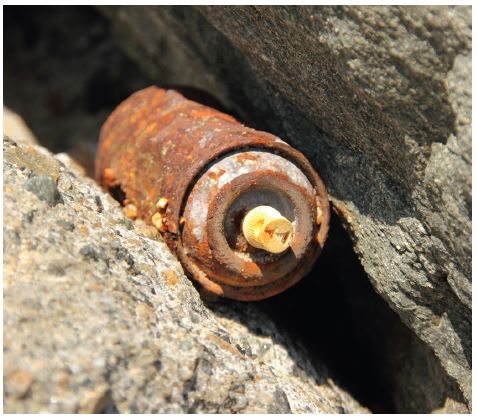Written on: April 1, 2023 by W. Stephen Tait
Hello, everyone. One of the most difficult questions to answer about corrosion is why it is so random. For example, you may open and inspect 12 traditional aerosol container spray packages after six months of storage stability testing to find:
• Five corrosion-free packages
• One package with corrosion on the liquid product area
• Three packages with corrosion in the vapor area
• One package with a pit in the product phase
• One package with corrosion and pitting in the bottom crevice (bottom double seam)
• One leaking at a pit that perforated the container body
The formula in this example was from the same batch, so the chemical composition is the same; all the packages came from the same pallet (i.e., manufactured at the same time); and all the packages were all filled at the same time. Should you:
a) Ignore the corroded and leaking packages;
b) Put the program on hold; or
c) Something else?
It would be even more frustrating if you found 11 corroded packages and one pristine, corrosion-free package. Why isn’t corrosion more consistent?
Variability is the culprit that causes the inconsistency of the observed corrosion in the same product-package system. Variability can also cause the unexpected appearance of corrosion in a previously corrosion-free commercial product, particularly if the corrosion tests were conducted with the wrong parameters.
There are three generic types of variability:
1. Within each individual package—package variability
2. Within individual product and package production batches—within-lot variability
3. Between different product and package production batches—lot-to-lot variability
The main corrosion causing/contributing factors associated with the generic types of variability are:
1. Product chemical composition
2. Package coating, valve coating and laminate film morphology (e.g., thickness and adhesion)
3. Laminate film and coating chemical compositions
4. Package geometry
a) Aerosol valve crimps (crevices)
b) Package crimps (crevices)
c) Aerosol container double seams (crevices)
d) Aerosol container and laminated foil bag welds
It has been my experience that variability of the package and laminated foil metal chemistries typically do not have a significant effect on spray package corrosion. Consequently, variations in foil and package-metal chemistries are not included in the above list.
The four associated factors could cause corrosion either by themselves or in combination with one or more of the others. Consequently, the number of combined factors could be very great. For example, there are 5,040 possible combinations for all of the above associated factors.
Let’s briefly discuss the relationship between the associated factors and the inconsistency of the observed spray package corrosion.

1) Product chemical composition
Small changes in chemical composition, such as pH, fragrance concentration or amount of water, could transform a benign formula into a package eater. Variability is exacerbated by lot-to-lot variations in raw materials. There are also chemistry differences and variations in raw materials from different sources, even when the specification for the different sources is nominally the same.
2) Package & valve laminate/coating morphology
This pertains to thickness, adhesion and metal wettability. Laminate films and coatings have variable thickness on individual packages, among packages within the same lot and among packages from different lots. Variability in the metal cleaning process and the coating application process could also produce small areas on individual package surfaces that lead to delamination and metal corrosion under the film or coating. Coatings from different sources could also produce a narrower or wider thickness range, even when the specifications for the two sources are nominally identical.
3) Laminate film & coating chemical compositions
Variations in the chemistry of laminate films and coatings could cause variability in how the coating adheres to the substrate metal. Variability in adherence could cause laminate/coating delamination with subsequent metal corrosion under the coating.
4) Package geometry
Spray package crevices are formed when:
• Aerosol valves are crimped to the container curls
• Rolling the bottom of a laminated foil bag or tube to form a seal
• Seaming aerosol container tops and bottoms to the container body
Not all crevices are created equal. Some have a large opening with a short length, some have a small opening with a long length and so on. The ratio of the crevice opening to its length is referred to as its aspect ratio.
Crevice aspect ratios interact with a formula’s chemical composition and physical properties to determine if and when crevice corrosion will occur, if the crevice corrosion will be general corrosion with or without pitting corrosion and how fast pitting crevice corrosion will penetrate the package metal or laminated foil.
Spray packages typically have a range of crevice aspect ratios within individual production lots and between different production lots. Consequently, crevice corrosion—with or without pitting—does not occur in every spray package unless the product is extremely corrosive.
Spray package welds might also be vulnerable to coating corrosion, laminated film corrosion and foil and metal corrosion. Corrosion vulnerability is determined by the interaction between a formula’s chemical composition and the weld.
There are two ways to account for variability when conducting corrosion tests:
1. Develop a database on how variability affects package corrosion for each product family in your line of spray products
2. Design your corrosion tests to include:
a) A large number of replicate samples for each variable
b) Variables with package components from different production lots
c) Variables with different concentrations of potential corrosion-causing formula ingredients, such as water
The corrosion test could be a storage test, an electrochemical test or a combination of both. Skipping corrosion stability tests and conducting tests with the wrong parameters might result in surprise corrosion in the marketplace.
Thanks for your interest and I’ll see you in May. Contact me at 608-831-2076; rustdr@pairodocspro.com or from our two websites: pairodocspro.com and aristartec.com. SPRAY